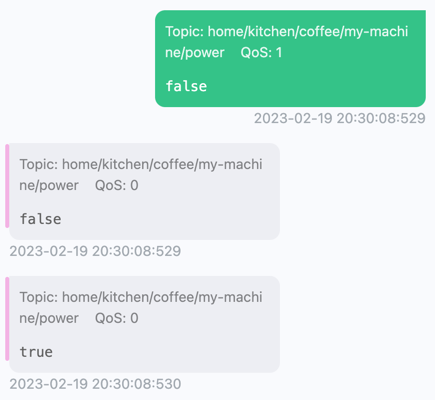A good coffee is what we desire.
This operator watches a MQTT topic and uses this to communicate with smart home appliances. The desired state of the appliance is stored inside kubernetes. Kubetl can then be used to turn the coffee machine on or off.
apiVersion: appliances.home.sijoma.dev/v1alpha1
kind: CoffeeMachine
metadata:
name: my-machine
namespace: default
spec:
power: trueRunning the following command will build the operator and set up a kind cluster with a mosquitto & home operator deployment.
make setup-test-envAfter running, you should see the following logs in mosquitto:
chown: /mosquitto/config/mosquitto.conf: Read-only file system
1676832927: mosquitto version 2.0.15 starting
1676832927: Config loaded from /mosquitto/config/mosquitto.conf.
1676832927: Opening ipv4 listen socket on port 1883.
1676832927: mosquitto version 2.0.15 running
1676832928: New connection from 10.244.0.6:36050 on port 1883.
1676832928: New client connected from 10.244.0.6:36050 as home-operator (p2, c1, k30).
The operator in the namespace home-operator-system, should also log mqtt connected.
The following sample will also be applied to the cluster. Hint: only the default namespace is so far supported.
apiVersion: appliances.home.sijoma.dev/v1alpha1
kind: CoffeeMachine
metadata:
name: my-machine
namespace: default
spec:
power: trueFirst describe the coffeemachine. Can you figure out when it was last turned on or off?
kubectl describe coffeemachines my-machine -n defaultNow edit the CRD, and turn the field power to false. Describe it again.
You can also take a look at the MQTT message by port-forwarding the service.
Then you need to subscribe to the topic home/kitchen/coffee/+/power. This can be
done for example with a tool like MQTTX.
kubectl port-forward -n mqtt svc/mosquitto 1883We tried to override the desired state by sending a manual mqtt message. The operator acted swiftly and turned the coffee machine back on (last message).
You’ll need a Kubernetes cluster to run against. You can use KIND to get a local cluster for testing, or run against a remote cluster.
Note: Your controller will automatically use the current context in your kubeconfig file (i.e. whatever cluster kubectl cluster-info shows).
- Install Instances of Custom Resources:
kubectl apply -f config/samples/- Build and push your image to the location specified by
IMG:
make docker-build docker-push IMG=<some-registry>/home-operator:tag- Deploy the controller to the cluster with the image specified by
IMG:
make deploy IMG=<some-registry>/home-operator:tagTo delete the CRDs from the cluster:
make uninstallUnDeploy the controller from the cluster:
make undeploy// TODO(user): Add detailed information on how you would like others to contribute to this project
This project aims to follow the Kubernetes Operator pattern.
It uses Controllers, which provide a reconcile function responsible for synchronizing resources until the desired state is reached on the cluster.
- Install the CRDs into the cluster:
make install- Run your controller (this will run in the foreground, so switch to a new terminal if you want to leave it running):
make runNOTE: You can also run this in one step by running: make install run
If you are editing the API definitions, generate the manifests such as CRs or CRDs using:
make manifestsNOTE: Run make --help for more information on all potential make targets
More information can be found via the Kubebuilder Documentation
Copyright 2023.
Licensed under the Apache License, Version 2.0 (the "License"); you may not use this file except in compliance with the License. You may obtain a copy of the License at
http://www.apache.org/licenses/LICENSE-2.0
Unless required by applicable law or agreed to in writing, software distributed under the License is distributed on an "AS IS" BASIS, WITHOUT WARRANTIES OR CONDITIONS OF ANY KIND, either express or implied. See the License for the specific language governing permissions and limitations under the License.

